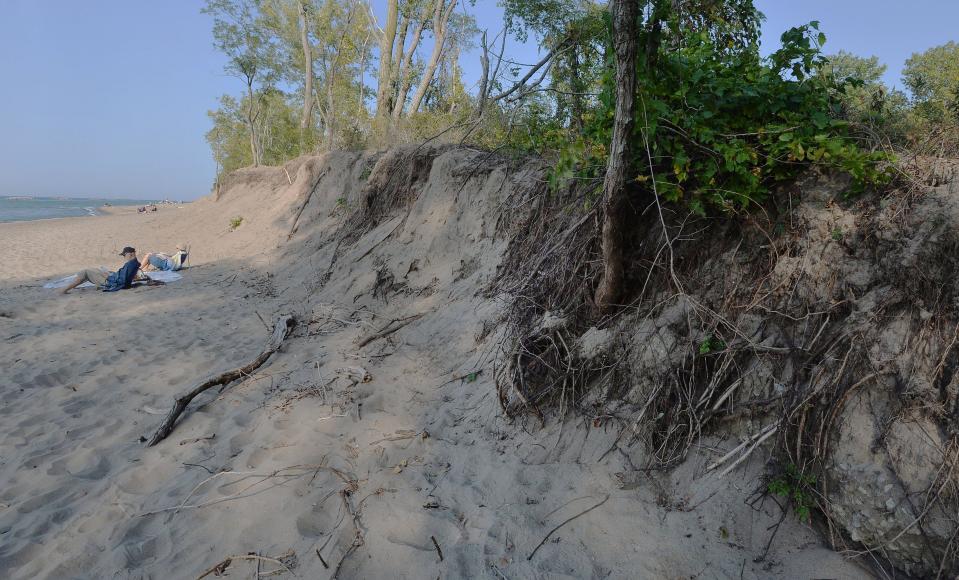Lake Erie water levels continue falling from record highs. What's ahead?
Lake Erie's water level rose to record highs in 2019 and 2020, damaging property and interfering with recreation before beginning a decline that continued into 2022. This year, the lake's level isn't projected to break any more monthly records but is expected to remain higher than average for the first six months.

The U.S. Army Corps of Engineers Detroit District compiles Great Lakes water level information on its website at lre.usace.army.mil. The data includes information going back to 1918, current levels and predictions for the future.
Where the Lake Erie level was
In 2022, Lake Erie water levels remained above average but were below the monthly mean record highs set in October, November and December of 1986; January of 1987; June, July, August and September of 2019; and February, March, April and May of 2020.
Lake Erie reached its highest level, 574.61 feet, in June 2019, according to Army Corps of Engineers records. In comparison, the lake's monthly mean levels in 2022 were more than a foot below that record high, reaching a maximum of 573.52 in July.

The Corps of Engineers' water level records for the Great Lakes date back to 1918 and show Lake Erie hitting all-time lows during the Great Depression. Record lows were set for Lake Erie in March through December 1934 and January 1935.
Lake Erie hit its lowest recorded water level, 568.18 feet, in February 1936, according to Corps records. In comparison, the monthly mean levels in 2022 were 3 feet to 5 feet above that record low.
For subscribers:High water levels, millions of 2020 visitors take toll on Presque Isle State Park
Where it is now
As January neared its end, Lake Erie was forecast to be at 572.01 feet, according to a Jan. 27 weekly Great Lakes water level update on the Corps Detroit District website. That was down 6 inches from a year ago and down from the January high of 573.69 feet, set in 1987. But the 572.01 feet was still about 13 inches above the long-term monthly average for Lake Erie for January.
Spring 2022 beach walk:Presque Isle beach conditions encouraging in wake of winter ice, lower water
What's ahead
In the first half of 2023, Lake Erie's water levels are expected to be lower than in 2022 by anywhere from 6 inches to 14 inches, according to predictions from the U.S. Army Corps of Engineers included in its December 2022 water level summary. The lake's levels also should be 22 inches to 28 inches below the record-high levels.

However, while a lower Lake Erie is predicted for this year, water levels for the first six months are still expected to be 6 inches to 7 inches above long-term average levels.
Other Great Lakes
The Army Corps of Engineers also forecast lake levels for the other Great Lakes for the first six months of 2023:
Lake Superior is expected to be 6 inches to 10 inches above 2022 levels from January to April and be within an inch of last year's levels in May and June; be 8 inches to 11 inches below record-high levels; and be 4 inches to 6 inches above long-term average levels.
What makes the Great Lakes great?:Take your pick of facts
Lake Michigan-Huron, which the Corps of Engineers lists as one, is predicted to be 4 inches to 7 inches below 2022 levels; be 30 inches to 33 inches below record highs; and be 4 inches above long-term average levels. Lake Michigan and Lake Huron are considered one lake for Army Corps forecasting purposes because the lakes are connected at the Straits of Mackinac and rise and fall together.
Lake Ontario is forecast to be 3 inches to 13 inches below levels from 2022; be 24 inches to 34 inches below record-high levels; and be within 2 inches of long-term average levels during the first six months of 2023.
Dana Massing can be reached at dmassing@timesnews.com. Follow her on Twitter @ETNmassing.
This article originally appeared on Erie Times-News: Lake Erie water levels down. What's ahead for Great Lakes?

